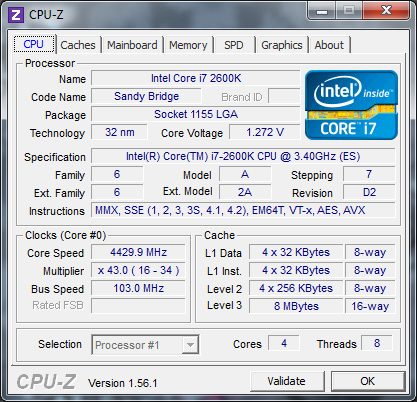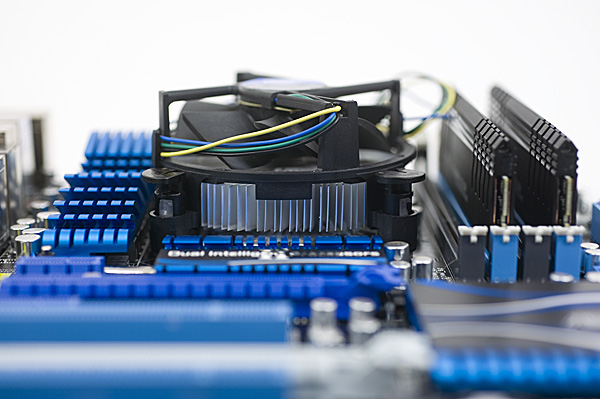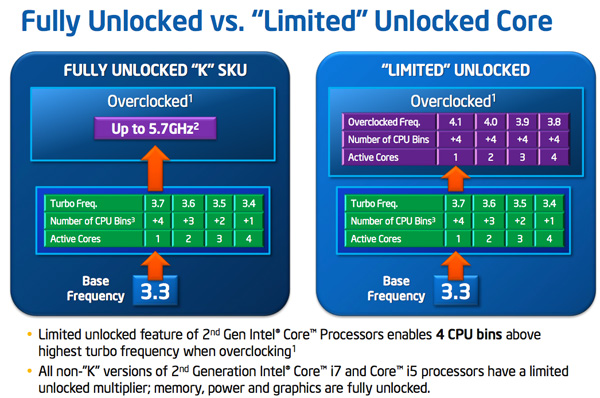The Sandy Bridge Review: Intel Core i7-2600K, i5-2500K and Core i3-2100 Tested
by Anand Lal Shimpi on January 3, 2011 12:01 AM ESTOverclocking, the K-Series and What You’ll Want to Buy
If you haven’t noticed, the computing world is becoming more integrated. We review highly integrated SoCs in our smartphone coverage, and even on the desktop we’re seeing movement towards beefy SoCs. AMD pioneered the integrated memory controller on desktop PCs, Intel followed suit and with Lynnfield brought a PCIe controller on-die as well. Sandy Bridge takes the next logical step and brings a GPU on-die, a move matched by AMD with Brazos and Llano this year.
In the spirit of integration, Intel made one more change this round: the 6-series chipsets integrate the clock generator. What once was a component on the motherboard, the PLL is now on the 6-series chipset die. The integrated PLL feeds a source clock to everything from the SATA and PCIe controllers to the SNB CPU itself. With many components driven off of this one clock, Intel has locked it down pretty tight.
With Nehalem and Westmere, to overclock you simply adjusted the BCLK from 133MHz to whatever speed you wanted and sometimes toyed with multipliers to arrive at a happy end result. With Sandy Bridge, the BCLK generated on the 6-series PCH is at 100MHz by default and honestly won’t go much higher than that.
While I’ve heard reports of getting as high as 115MHz, I’d view 103—105MHz as the upper limit for what you’re going to get out of BCLK overclocking. In other words: next to nothing. A 105MHz BCLK overclock on a Core i7-2600 will take you from a stock speed of 3.4GHz to a whopping 3.57GHz. The form of overclocking we’ve been using for the past decade is effectively dead on Sandy Bridge.
Years ago, before the Pentium II, we didn’t rely on BCLK (or back then it was just FSB or bus overclocking) to overclock. Back then, if we wanted a faster CPU we’d just increase the clock multiplier. Intel has dabbled in offering multiplier unlocked parts for overclockers, we saw this last year with the Core i7 875K for example. With Sandy Bridge, those unlocked parts are going to be a lot more important to overclockers.
It works like this. If you have a part that does not support Turbo (e.g. Core i3-2100 series), then your CPU is completely clock locked. You can’t overclock it at all, have fun at your stock frequency. This is good news for AMD as it makes AMD even more attractive at those price points.
If you have a part that does support turbo (e.g. Core i5-2400), then you have what’s called a “limited unlocked” core—in other words you can overclock a little bit. These parts are limited to an overclock of 4 processor bins above and beyond the highest turbo frequency. Confused yet? This chart may help:
In this case we’re looking at a Core i5-2500, which runs at 3.3GHz by default. When a single core is active, the chip can turbo up to 3.7GHz. If you want, you can change that turbo state to go as high as 4.1GHz (if your CPU and cooling can keep up).
Overclocking these limited unlocked chips relies entirely on turbo however. In the case above, the fastest your chip will run is 4.1GHz but with only one core active. If you have four cores active the fastest your chip can run is 3.8GHz. While Intel didn’t sample any limited unlocked parts, from what I’ve heard you shouldn’t have any problems hitting these multiplier limits.
There’s a third class of part: a fully unlocked K-series chip. At launch there are only two of these processors: the Core i5-2500K and the Core i7-2600K. Anything with a K at the end of it means you get all multipliers from 16x all the way up to 57x at your disposal. It’s effectively fully unlocked.

These chips overclock very well. Both my Core i5-2500K and Core i7-2600K hit ~4.4GHz, fully stable, using the stock low-profile cooler.

This is all you need for 4.4GHz
With a bit more effort and a better cooler, you can get anywhere in the 4.6-5.0GHz range:

It's a bit too early to tell how solid these near-5GHz overclocks will be, but I'm confident in the sub-4.5GHz overclocks we were able to sustain.
You do pay a price premium for these K-series SKUs. The 2500K will cost you another $11 over a stock 2500 and the 2600K costs an extra $23. In the case of the 2500K, that’s a small enough premium that it’s honestly worth it. You pay $11 extra for a chip that is very conservatively clocked and just begging for you to overclock it. Even the 2600K’s premium isn’t bad at all.
| Model Number | Standard SKU | K-Series SKU | Price Premium |
| Intel Core i7-2600 | $294 | $317 | +$23 |
| Intel Core i5-2500 | $205 | $216 | +$11 |
As an added bonus, both K-series SKUs get Intel’s HD Graphics 3000, while the non-K series SKUs are left with the lower HD Graphics 2000 GPU.
Compared to Lynnfield, you’re paying $11 more than a Core i5-760 and you’re getting around 10-45% more performance, even before you overclock. In a perfect world I’d want all chips to ship unlocked; in a less perfect world I’d want there to be no price premium for the K-series SKUs, but at the end of the day what Intel is asking for here isn’t absurd. On the bright side, it does vastly simplify Intel’s product stack when recommending to enthusiasts: just buy anything with a K at the end of it.
Since we’re relying on multiplier adjustment alone for overclocking, your motherboard and memory actually matter less for overclocking with Sandy Bridge than they did with P55. On both P67 and H67, memory ratios are fully unlocked so you can independently set memory speed and CPU speed. Even the GPU ratios are fully unlocked on all platforms and fully independent from everything else.












283 Comments
View All Comments
RMSe17 - Monday, January 3, 2011 - link
Time for an upgrade :)marc1000 - Monday, January 3, 2011 - link
I decided to jump the first core-i lineup, and sitck to an old core2duo for some more time... now seems the wait was worth it!I just hope the prices outside US/Europe will be reasonable..
thanks Anand,
vol7ron - Monday, January 3, 2011 - link
I think there are many of us that had the same idea. Unless needing to upgrade due to malfunction or new laptop purchase, holding C2D til past the i-Series was the best move to make; whereas buying into C2D asap was the best move at the time.Still going to wait for prices to fall and more USB3 adoption. Expected new purchase: mid-2011-mid 2012
vol7ron - Monday, January 3, 2011 - link
by "i-Series" it should have said "1st gen. i-Series"CptTripps - Tuesday, January 4, 2011 - link
Ya know I usually do as you are but was an early adopter of the i7 920. Looking now it seems I made the right choice. I have had 2 years of kickassery and my processor still holds up rather well in this article.hogey74 - Thursday, January 6, 2011 - link
Me too! I've got an e8400 running at 3.9 with almost zero OC know-how and its done me well. I might snap up an i7 if they and their mobos get cheap when sandy bridge has been out a few months... but may well skip that generation all together.Einy0 - Monday, January 3, 2011 - link
Holy crapola AMD really needs Bulldozer now. Even in heavily threaded video encoding the 2600K at $300 is blowing the 1100T x6 out of the water. This is the the Core 2 Duo vs. A64 X2 all over again. Will Bulldozer be another Phenom, a day late and a dollar short? TLB bug anyone? As a PC enthusiast I really want to see competition to keep prices in check. If I had to upgrade today, I can't see how I could turn down the 2600K...medi01 - Monday, January 3, 2011 - link
Did you add mobo price into equation?I don't get all the excitement, really. If anything, Intel's anti-overclocking moves
MonkeyPaw - Monday, January 3, 2011 - link
Yeah, new Intel motherboard models are never cheap. I don't understand why the price remains so high when more an more functionality is moving to the CPU. The other killer is that you need a new board for every Intel CPU update.Lastly, it's hard to throw the "buy now" tag on it with AMD's new architecture over the horizon. Sure, AMD has a tough act to follow, but it's still an unknown that I think is worth waiting for (if it's a dog, you can still buy Intel). Keep in mind that Bulldozer will have a pretty strong IGP, one that may make decent IGP gaming a reality. It will become a matter of how powerful the x86 portion of the Bulldozer is, and they are trying a considerably different approach. Considering the amount of money you'll be paying, you might as well see how AMD shakes out. I guess it just depends on if what you have today can get you by just a little longer.
dertechie - Monday, January 3, 2011 - link
You're conflating Bulldozer and Llano there. Bulldozer is the new architecture, coming to the desktop as an 8-core throughput monster. Llano is the first desktop APU, cramming 4 32nm K10.5 cores and a Redwood class GPU onto the die. The next generation of desktop APUs will be using Bulldozer cores.